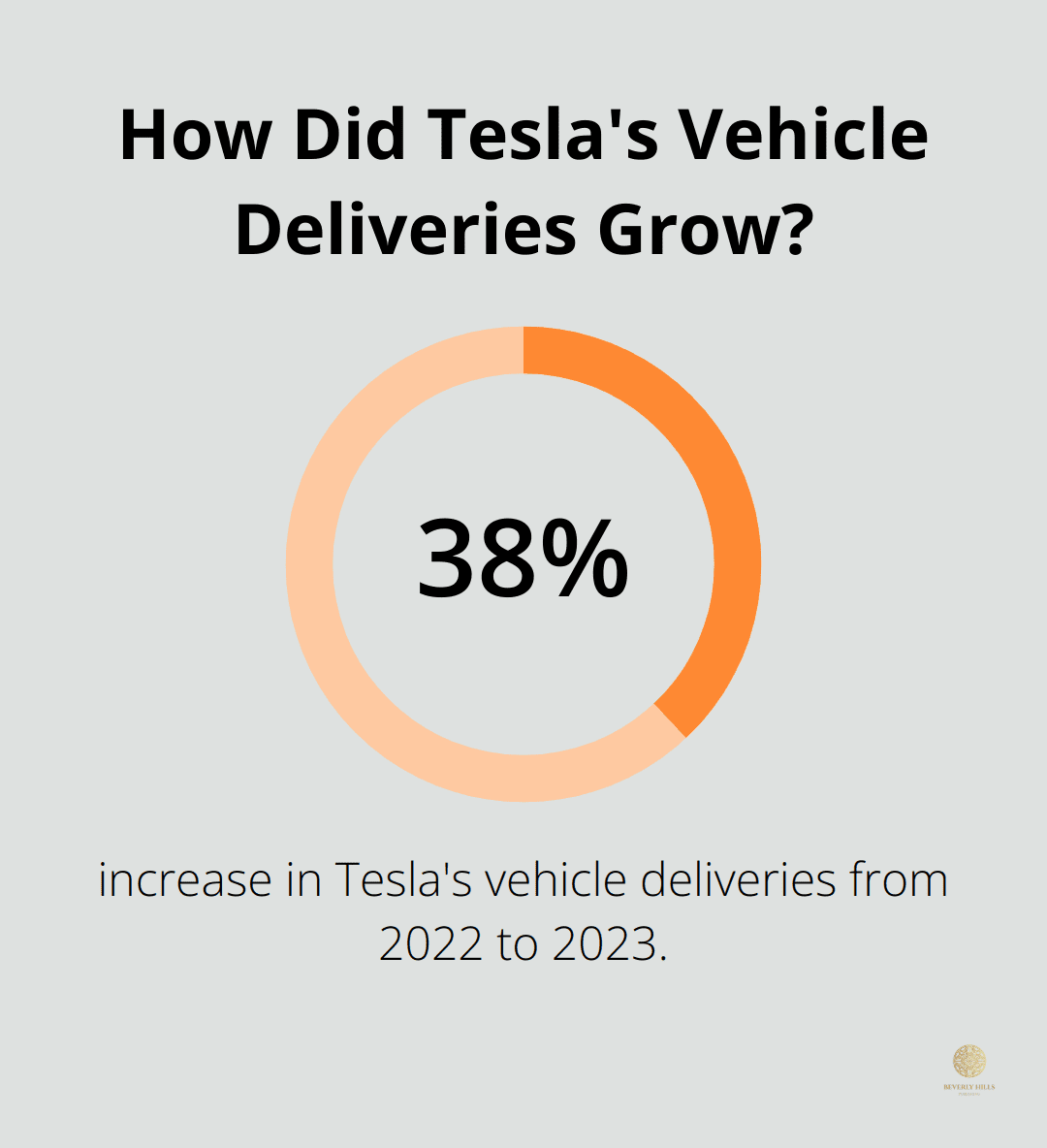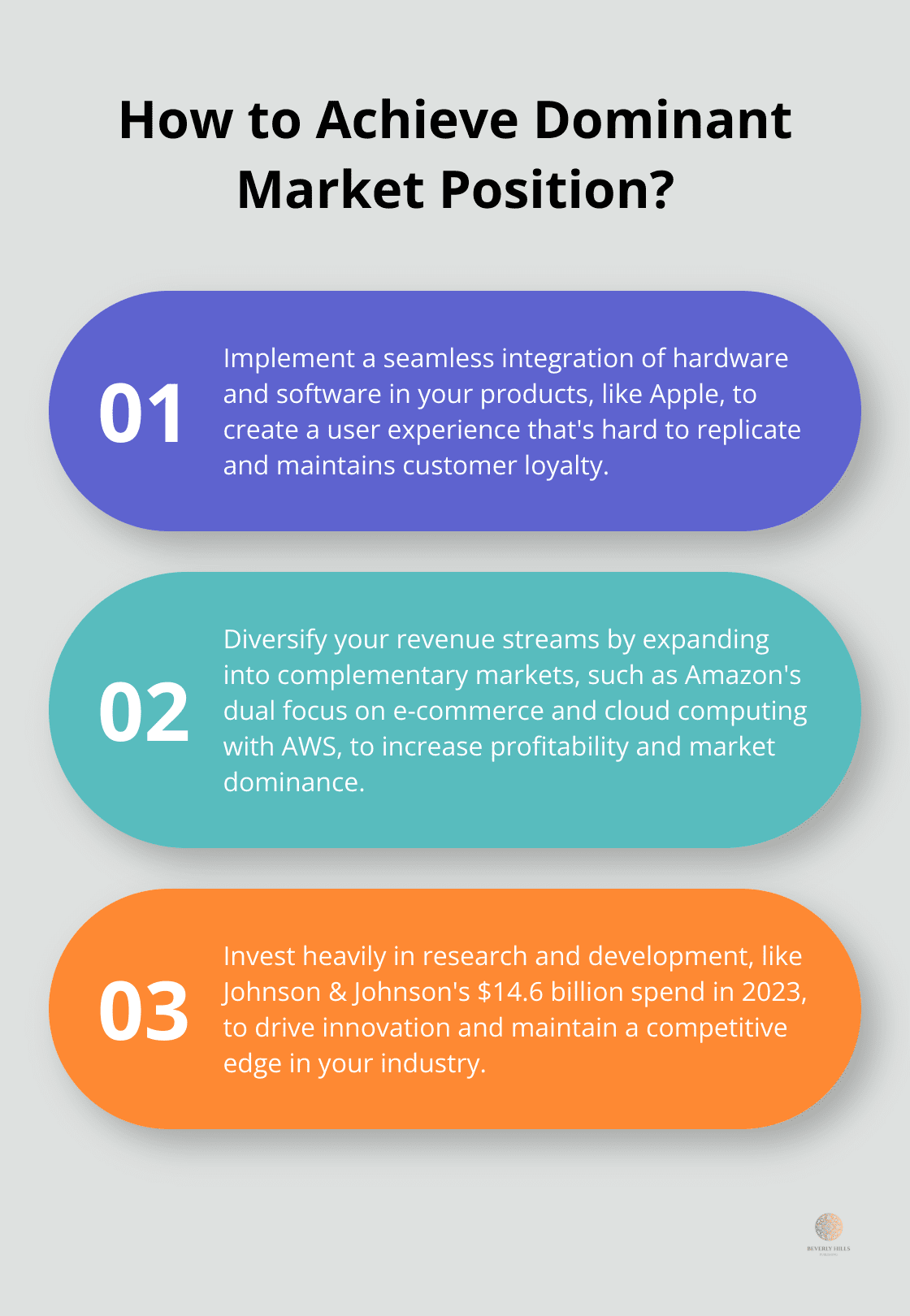At Beverly Hills Publishing, we’re fascinated by the companies that shape our world. This blog post explores the market leaders in each industry, from tech giants to traditional powerhouses and emerging innovators.
We’ll examine what sets these companies apart and how they’ve maintained their dominance. Join us as we uncover the strategies and innovations that have propelled these industry titans to the top.
Tech Titans Who Rule the Digital World
The digital landscape has witnessed the rise of a few companies to unprecedented levels of power and influence. These tech giants have reshaped how we live, work, and interact with technology. Let’s explore the key players dominating the digital realm and their strategies for maintaining market leadership.
Apple’s Ecosystem Dominance
Apple’s target market consists mainly of younger to middle-aged consumers, with a slight popularity edge among women. The company’s success stems from its seamless integration of hardware and software, creating a user experience that’s hard to replicate.
Amazon’s Dual Powerhouse
Amazon has transformed from an online bookstore to a dual powerhouse in e-commerce and cloud computing. With over 200 million Prime members worldwide, Amazon dominates online retail. But Amazon Web Services (AWS) has become the company’s profit engine, controlling 50.1% of the cloud provider market share in 2024.
Google’s Search and Ad Empire
Google’s name has become synonymous with internet search, commanding over 90% of the global search engine market share. This dominance translates directly into advertising revenue. Google’s ability to deliver highly targeted ads based on user data has made it an indispensable tool for marketers worldwide.
Microsoft’s Software and Cloud Surge
While often overlooked in consumer-facing discussions, Microsoft’s influence in enterprise software and cloud services is immense. Microsoft 365 (formerly Office) remains the standard for productivity software, used by over 1 million companies globally. Azure, Microsoft’s cloud platform, has seen explosive growth, now holding 23% of the cloud market share and rapidly closing the gap with AWS.

These tech titans have achieved their status through a combination of innovation, strategic acquisitions, and the network effects of their platforms. However, their dominance has also led to increased scrutiny from regulators concerned about monopolistic practices. The ability of these companies to navigate regulatory challenges while continuing to innovate will determine their future market leadership.
As we shift our focus from the digital realm, let’s examine the titans of traditional industries who have maintained their dominance in sectors that have shaped our economy for decades.
Titans of Traditional Industries
Walmart’s Retail Revolution
Walmart stands as the world’s largest retailer, operating over 10,500 stores globally and generating $611 billion in revenue for fiscal year 2023. The company’s success stems from its unwavering focus on low prices and operational efficiency. Walmart has successfully expanded into e-commerce, with online sales growing 26% in 2023. The company’s Walmart+ membership program (launched to compete with Amazon Prime) now boasts over 25 million subscribers.
ExxonMobil’s Energy Evolution
ExxonMobil maintains its position as one of the world’s largest oil and gas companies, despite increasing pressure from renewable energy sources. In 2023, ExxonMobil reported revenues of $413.7 billion. The company invests heavily in carbon capture and storage technologies, pledging to spend $15 billion on lower-emission energy solutions by 2027. This strategic pivot aims to maintain ExxonMobil’s relevance in an increasingly carbon-conscious world.
Toyota’s Automotive Innovation
Toyota continues to lead the global automotive industry, selling 10.5 million vehicles in 2022. The company’s success builds on its reputation for reliability and its early adoption of hybrid technology with the Prius. Toyota now invests $35 billion in electric vehicle development, aiming to launch 30 EV models by 2030. This commitment to innovation ensures Toyota’s continued leadership in the evolving automotive landscape.
Johnson & Johnson’s Healthcare Transformation
Johnson & Johnson remains a healthcare powerhouse, with 2023 sales reaching $85.2 billion. The company’s diverse portfolio spans pharmaceuticals, medical devices, and consumer health products. J&J’s focus on research and development (spending $14.6 billion in 2023) has led to breakthrough treatments in areas like oncology and immunology. The company’s recent spinoff of its consumer health division allows for greater focus on high-growth pharmaceutical and medical device segments.

These traditional industry leaders prove that longevity in business requires adaptation and innovation. Their ability to embrace new technologies and respond to changing consumer needs allows them to shape their industries and our economy at large. As we shift our focus to emerging market leaders, we’ll explore how new companies disrupt established industries and create entirely new markets.
Disruptors Reshaping Industries
Tesla’s Electric Revolution
Tesla accelerated the transition to electric vehicles (EVs). In 2023, Tesla delivered over 1.8 million vehicles, a 38% increase from the previous year. This growth stems from the company’s focus on innovation and vertical integration. Tesla’s Gigafactories produce not just cars, but batteries, solar panels, and energy storage systems, creating a complete ecosystem for sustainable energy. By July 2023, Gigafactory Shanghai achieved an impressive annual production capacity exceeding 750,000 vehicles.

Tesla’s impact extends beyond its own sales. The company’s success forced traditional automakers to accelerate their EV plans. General Motors now plans to phase out internal combustion engines by 2035, a direct response to Tesla’s market disruption.
Nvidia’s AI Acceleration
Nvidia transformed from a graphics card manufacturer to the backbone of the AI revolution. The company’s GPUs power everything from autonomous vehicles to large language models. In fiscal year 2024, Nvidia reported revenue of $60.9 billion, a 126% increase from the previous year.
Nvidia’s dominance in AI chips made it an essential partner for tech giants and startups alike. Nvidia’s CUDA platform became the de facto standard for AI development, creating a moat that competitors struggle to cross. GPUs perform technical calculations faster and with greater energy efficiency than CPUs, delivering leading performance for AI training. As AI applications expand, Nvidia’s influence will likely grow even further.
Netflix’s Content Empire
Netflix redefined how we consume entertainment. With over 260 million subscribers worldwide (as of Q4 2023), Netflix became a cultural powerhouse. The company’s success stems from its data-driven approach to content creation and its willingness to invest heavily in original programming.
Netflix spent $17 billion on content in 2023, a figure that dwarfs traditional media companies. This investment paid off, with Netflix originals like Stranger Things and Squid Game becoming global phenomena. The company’s ability to deliver personalized content recommendations keeps viewers engaged, reduces churn, and drives growth.
Beyond Meat’s Protein Revolution
Beyond Meat leads the plant-based protein movement, challenging the traditional meat industry. While the company faced challenges (including a 20.5% decrease in net revenues in Q3 2023), its impact on the food industry remains undeniable. Beyond Meat’s products are now available in over 130,000 retail and foodservice outlets across 90 countries.
The company’s success spurred major food companies to develop their own plant-based alternatives. This competition drives innovation and reduces prices, making plant-based options more accessible to consumers. As environmental concerns grow, Beyond Meat and its competitors position themselves to capture a larger share of the global protein market.
These disruptors share common traits: they challenge industry norms, focus on innovation, and create new markets. Their success demonstrates that even entrenched industries remain vulnerable to disruption when innovative and entrepreneurial companies offer compelling alternatives.
Final Thoughts
Market leaders in each industry share common traits that propel them to success. These companies invest heavily in research and development, build strong brand identities, and leverage data-driven decision-making. They remain agile, willing to disrupt their own business models before competitors do. The future will likely see new market leaders emerge in fields such as artificial intelligence, sustainable energy, and personalized medicine.

Potential disruptors are already on the horizon, with quantum computing, blockchain, and advanced robotics poised to reshape various sectors. These technologies could revolutionize industries from finance to manufacturing, creating opportunities for innovative companies to claim market leadership. The business world remains dynamic, offering ample opportunities for companies that embrace innovation and strategic positioning.
At Beverly Hills Publishing, we understand the power of innovation in establishing market leadership. We help authors position themselves as leading authorities in their fields through our unique publishing approach (combining groundbreaking techniques with strategic branding). This strategy mirrors the success of top market leaders across industries, setting authors up for long-term success in their respective niches.















































































































































































































































